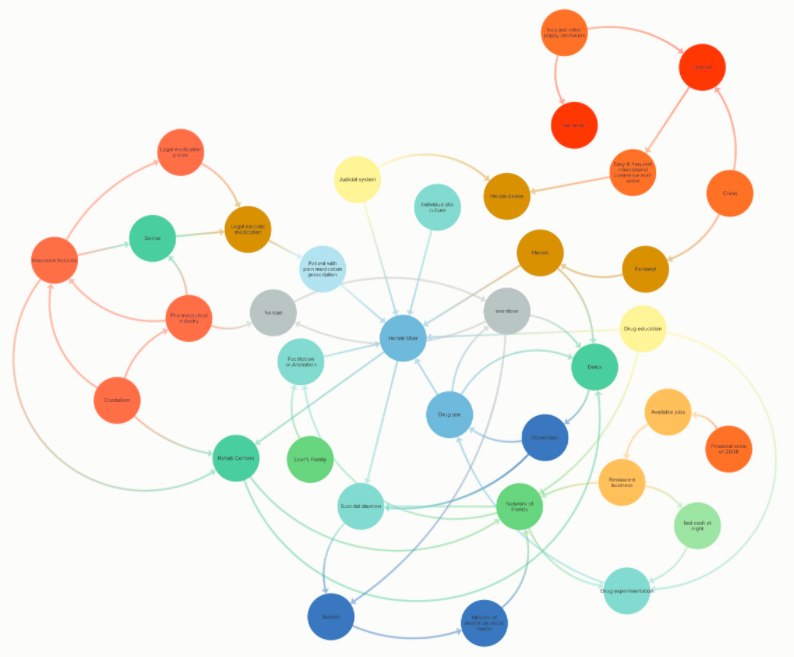The Wickedest Problem of All
Posted on October 31, 2017While living abroad, I stayed connected to what was going on in the US through my Facebook feed and news coverage by the BBC and CNN. What was going on in my place of origin was important to me–how else could I keep up with what “my people” were faced with daily? Life is so different in South America, much of the news was terrifying and very hard to imagine happening to my friends and loved ones. A topic that got a lot of coverage by both the news and my social media is, in my opinion, the most wicked problem of them all: the opioid epidemic. People I know are tangled deep in this wicked problem, some of them very dear to my heart. Thinking about all of the different factors in play is truly overwhelming.
We use the term “wicked” in a meaning akin to that of “malignant” (in contrast to “benign”) or “vicious” (like a circle) or “tricky” (like a leprechaun) or “aggressive” (like a lion, in contrast to the docility of a lamb). (1)
Trying even to comprehend the problem and its causes is nearly impossible. This systems map created for the purposes of this essay demonstrates most of the forces acting against my friends with addiction problems:

Here, the multiple forces directly touching the user:

<iframe src=”https://embed.kumu.io/bcf8a1831e1935706794ec981445731c” width=”940″ height=”600″ frameborder=”0″></iframe>
https://embed.kumu.io/bcf8a1831e1935706794ec981445731c
Every wicked problem can be considered to be a symptom of another problem. (1)
People argue that people start taking drugs because they’re lonely or don’t have social support systems, that our individualist society and culture is feeding the problem leaving people to their own defenses (7). Some say it’s because they’re prescribed prescription narcotics and through illicit use after the prescription, become physically addicted to synthetic opioids and later search for cheaper options (4). Yet others argue that it’s because they have personality disorders and need psychiatric help (6). None of these are comprehensive analyses of the entire system at play.
The existence of a discrepancy representing a wicked problem can be explained in numerous ways. The choice of explanation determines the nature of the problem’s resolution. (1)
So, then, “solutions” are sought that only address part of the problem. For example, families generally send people with addiction problems to drug rehabilitation facilities. There, they create support networks, receive psychological counseling, detox and aren’t physically addicted when they leave; a seemingly perfect solution to the problem. However, failure to address that rehabilitation facilities create social networks of other drug users makes the rehabilitated individuals even more susceptible to relapse after care. These rehabilitation centers are wildly popular enterprises in places like South Beach, Florida and are run by capitalist systems that thrive financially from their failure in permanently rehabilitating an opioid user. They rely on patient relapse to perpetuate the cycle and fund their facilities.
The destruction they cause is often blamed on particular actors or events, although it is actually a consequence of system structure. Blaming, disciplining, firing, twisting policy levers harder, hoping for a more favorable sequence of driving events, tinkering at the margins–these standard responses will not fix structural problems. (2)
The families’ and friends’ only resource in helping their addicted loved ones are these types of facilities. They are encouraged to stop financially and emotionally enabling the user who many times with no stable income, loses access to health insurance and cannot continue going to the better (or less bad) rehabilitation centers. Their families and loved ones, usually after being treated poorly by the user, alienate and abandon them. Many times, the judicial system gets involved after the users engage in illegal activity in order to feed their habits or because they are left homeless after relapse.
But some systems are more than surprising. They are perverse. These are the systems that are structured in ways that produce truly problematic behavior; they cause us great trouble. (2)
When further unpacking the entire opioid crisis, one is unsurprisingly very surprised. The bigger forces behind opioid consumption are the pharmaceutical industries and big-name international drug manufacturers like OxyContin (3) and foreign production in countries like Afghanistan (5) and China (9). OxyContin’s “aggressive, excessive and inappropriate marketing very much exacerbated abuse and criminal trafficking” (3) of the prescribed synthetic opioid. Because the affluence of their industry is now being threatened by cheaper illegal alternatives such as heroin laced with deadly fentanyl, they aspire to expand profits to the global marketplace.
As we seek to improve the effectiveness of actions in pursuit of valued outcomes, as system boundaries get stretched, and as we become more sophisticated about the complex workings of open societal systems, it becomes ever more difficult to make the planning idea operational. (1)
So, in the end, we are left with organizations like the Partnership for a Drug-Free New Jersey intervening by putting signs on public transportation and other half-hearted, single-perspective, futile attempts at change. “Would you give your child heroin for a broken arm?” Obviously not. Do these solutions make a dent in deterring the opioid crisis? Does it stop friends and loved ones from committing suicide after being stuck in the vicious cycle of addiction?

Different approaches to tackle the wickedest of problems are essential. Strategic design of solutions that are dynamic and that embrace emergence must commence. Consideration of as many stocks, flows, and actors as possible in the complex tangled system will determine success in causing bigger change. I’ve already witnessed so many young, vibrant people meet untimely deaths. I pray that there is some hope for those that are left.
Megan L. Willy
Bibliography of Works Cited:
- Horst Rittel and Melvin Webber, “Dilemmas in a general theory of planning”.
- Donella H. Meadows, “Thinking in Systems”.
- Harriet Ryan, Lisa Girion and Scott Glover, “OxyContin Goes Global: ‘We’re only just getting started’”. LA Times: 2016 December 18. http://www.latimes.com/projects/la-me-oxycontin-part3/
- Partnership for a drug-free New Jersey: NJ Transit PATH Advertisement.
- Azam Ahmed, “Tasked with Combating Opium: Afghan Officials Profit from It”. NY Times: 15 February 2016. https://www.nytimes.com/2016/02/16/world/asia/afghanistan-opium-heroin-taliban-helmand.html
- Maia Szalavitz, “Opioid Addiction is a Huge Problem, but Pain Prescriptions Are Not the Cause”. Scientific American: 10 May 2016. https://blogs.scientificamerican.com/mind-guest-blog/opioid-addiction-is-a-huge-problem-but-pain-prescriptions-are-not-the-cause/
- Johann Hari, “Everything you know about addiction is wrong”. TED Talk: June 2015. https://www.ted.com/talks/johann_hari_everything_you_think_you_know_about_addiction_is_wrong#t-151074
- Margaret Talbot interview with host Dave Davis, “What Happens When the Heroin Epidemic Hits Small Town America?” NPR Fresh Air Podcast: 29 June 2017.
- Sean O’Connor, “Fentanyl: China’s Deadly Export to the United States”. US-China Economic and Security Review Commission, Staff Research Report: 1 February 2017.